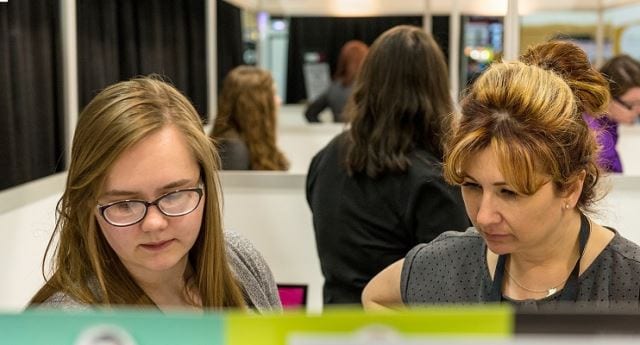by Lesley Martin
A decade ago, Dana Esposito met Professor Bonnie Higgins at ExhibitorLive!. Higgins, who teaches at Bemidji State University, quickly gathered that Esposito is a friendly and active professional in the industry. She invited Esposito to become a mentor through the University Affiliations Committee with the Experiential Design Professionals Association.
Esposito would be paired with a student enrolled in the exhibit design programs at BSU or the Fashion Institute of Technology. Esposito, who is a creative director at Elevation Exhibits in Shrewsbury, Mass., would guide the student with her designs and introduce her to the world of exhibitions.
Opportunity to nurture fledging designers
When Esposito learned of the program, she knew that she had to become the mentor she wished she had as a student. “When I got my start, the industry was not a warm and fuzzy place,” said Esposito, who entered the industry when the economy was down and the competition fierce. Wherever she worked, she encountered an us-versus-them culture.
In her heart, Esposito sees colleagues, other professionals and companies as pieces to the puzzle of the exhibitions industry. Through the mentorship program, Esposito’s passion for growing others shines. She is now co-chair of the committee with Justin Dworak of Star Exhibits.
“These students are given access to a person who they wouldn’t be able to reach otherwise,” says Esposito, who received the program organizer role from Joel Katzowitz of Czarnowski. “We tell the students, ‘You have access to a massive amount of experience at your fingertips. These professional designers are volunteering to help you, and you can ask them anything.”
Through phone and email, the students (located in Minnesota and New York) share their designs with working professional designers. They can ask questions and gather feedback on their designs, and are also encouraged to learn beyond the assignment, such as how to receive feedback, handle salespeople, and manage anxiety. “We tell the students, ‘You are entering a partnership and it will be as amazing, or not, as you make it. You’ve been given a gift. Take advantage of it.’”
Taking a young designer to the roots
Stephen Ross remembered a time when he was reviewing his student’s designs online. She was feeling stuck creatively, so Ross encouraged her to freehand her work. However, she felt like she had to work within the design program to accomplish the task. “I explained that she could go outside the boundaries of her technology and actually print something out, draw on it, and understand where she can make the tweaks,” says Ross, who is vice president and executive creative director of Access TCA in Whitinsville, Mass.
After coaxing her to give it a try, Ross persuaded her to “take a leap of faith” to concept her work freehand, then digitize it in the program. “It was very liberating for her,” says Ross.
Professional development of industry pros
While the mentorship experience is intended to help the students, the mentors gain as well. They become re-energized by the excitement, gain confidence by sharing knowledge, and get in touch with the latest trends.
For the seasoned creative professional, working with an enthusiastic young designer “reminds them how cool it is what we do and re-energizes them,” said Esposito. Ross echoed Esposito and said, “I love being able to talk design with young designers. It’s inspiring to hear their enthusiasm for it.”
Other mentors gain confidence by sharing their knowledge. There were no college courses offered in exhibit design when the mentors were in school 20 years ago. “Like most designers of my generation, there was no specific Exhibition Design curriculum. We are interior, industrial, and/or graphic designers who stumbled into the field and most times, never left!” said Cipolla, a design director, who has designed for more than 17 years at Czarnowski. “I surprise myself when I confidently impart knowledge or advice. It’s very empowering,”
For a busy working professional who is working overtime on a deadline, they have little room to be curious or open to other ways of thinking. When working with the student, the mentors get a chance to entertain new ways of thinking. “Mentoring reminds me to think abstractly, to be curious and to network and/or collaborate more than I might with a busy schedule,” said Cipolla.
When a student is still learning what they can and cannot do, they may suggest an idea that’s impossible, but interesting to entertain or holds a creative golden nugget. “A naïve idea can still be a good idea,” said Esposito.
Additionally, the mentors get in touch with the latest trends and technology. Students entering the industry use the newest software and are eager to work. “Mentoring the students reminds me to hone my skills and stay in the game,” says Cipolla, “because there are very hungry and talented designers right on my heels!”
Industry reins in talent
The mentors are enthusiastic to mentor the students. Esposito tells the student to take full advantage of their mentors. “We tell the students to use your mentor as much as possible – email them, call them, connect with them on LinkedIn,” says Esposito.
If possible, the two might meet through a trade show. Esposito tells the students to check if their mentor is at a show that they could attend – most often, that’s ExhibitorLive!. “If their mentee is attending, I ask the mentors, ‘Will that help you get a chance to go to Exhibitor?’” said Esposito, who has been an active industry member and is president emeritus of the Northeast EDPA chapter.
Amongst the designers who meet the students and other industry professionals, the future of the industry is closely knit. “We get to meet the cream of the crop in the industry and follow them along their [career] path,” says Ross, who meets students at ExhibitorLive!.
Businesses that are always ready to hire top talent will get to know new names. And even if the exhibit company is not yet ready to hire another designer, they will make connections just by participating.
Nourishing creativity
Sometimes designers aren’t given the opportunity to attend a trade show. But people who work in creative roles are expected to stay up with the latest trends and technology. Esposito, who has been a designer for Elevation for seven years, says, “Designers are like dry sponges if you hold them too close.” Esposito has been able to travel and says, “I feel more loyal to my company because of it.”
Through their new networks, young designers are propelled down the career path and often land a job upon college. “Once in a while, scoop them up and offer them a position. That’s rewarding,” said Ross.
Matchmaking mentees to mentors
Every year, Esposito averages between 24-30 pairings (and the number of students is trending up). Ross, who is mentoring his fifth student, said “Dana has a really good sense of what her industry friends are like. She knows how they like to explain things and teach,” says Ross, who’s been a mentor throughout his career. “She has done a great job matching me with students that need the qualifications that I can bring to the relationship.”
Knowing the personalities of the mentees is a little trickier. If possible, Esposito likes to meet the students face-to-face. She might meet them when they were junior students at an event, whether on campus or in a convention center. Last year, Esposito asked the professors from each university to write cheat sheets about the students. “I was able to see beyond the resume with lovely descriptions of these people. I could see a glimpse into who they are as a person.”
Mentors become emotionally invested
If Larina Cipolla’s student is from FIT, she will attend the Capstone Thesis Review at FIT in New York. It’s been a year’s journey for the student and Cipolla, and now the student must present the work. “I always feel anxious the night before for the students. You could call it sympathy pains!” says Cipolla.
The morning of, the student will practice the presentation with CIpolla. She guides them and builds their confidence. “With every student, I really try to give them some positive feedback early in their presentation. I want to build their confidence and create a receptive space for them. And while I will occasionally challenge, I’ll never trip them up.”
After years of working on pitches, Capstone is the one day that Cipolla jokes that this is the day she gets to receive rather than give a pitch and although she’s not presenting, she feels the same anxiety. “I love the collective feeling of butterflies,” says Cipolla. “It’s fun to be in a forum with peers and competitors, all for a great cause: the future of exhibit design!”
Mentoring one other
In the last three years, Esposito and a handful of colleagues revived the Northeast EDPA Chapter. She began as secretary, then became vice president and president. With the chapter’s mission speaking to maintaining a sustainable industry, she believes that collaboration and education protects the future of the industry. People outlast companies, and meeting face-to-face creates connections that build the network.
“Our industry–like any other industry–exists to make a profit; in our case, we make a living by producing experiential marketing,” says Kevin Fett, president and CEO of Ion Exhibits and EDPA Midwest chapter president. “However, we all agree we’re here to ‘send the elevator back down.’” Appreciative members of the industry want to “give more than to receive,” and the chapter offers opportunities for networking, education, and charitable works.
In addition to BSU and FIT, the Illinois Institute of Art connects students with the trade show industry. Last year, 27 students paired with a designer and joined the Midwest chapter’s Presenter’s Challenge – its most attended event that included 85 executives last year.
With the success of IIA, Fett looks to expand the college-level connections to include project management and sales students. The health of the industry depends upon bringing in fresh and eager talent.
What advice would you give your younger self?
Dana Esposito: “This industry is exciting, addictive, and takes weekend and holidays from you while pouring stress and deadlines all over you. So my advice would be to start young when you start taking great care of your brain, body and spirit. Never stop guarding your health.”
Stephen Ross: “A lot of times, designers are under pressure to learn how to be under pressure. You’re always afraid of failing because you think it’s your last job, or your last design. My advice would be: ‘Don’t be afraid to fail. If you stub your toe, learn from it.’”
Larina Cipolla: “Learn stress management. Don’t procrastinate, start early, honor the design process and do the work. Loosen your grip and submerge yourself in the information–it will sink in and clarity will come. If not, get up and go for a walk and stop thinking about it. Finally, don’t ignore your original idea. Get it out and look at it. It’s either the right answer or in the way of the right answer.”
This story originally appeared in the March/April issue of Exhibit City News, p. 78. For more pictures and original layout, visit https://issuu.com/exhibitcitynews/docs/mar-apr_ecn2018































